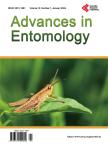Malpighian Tubules in Larvae of Diatraea saccharalis (Lepidoptera;Crambidae): A Morphological Comparison between Non-Parasitized and Parasitized by Cotesia flavipes (Hymenoptera;Braconidae)
Malpighian Tubules in Larvae of Diatraea saccharalis (Lepidoptera;Crambidae): A Morphological Comparison between Non-Parasitized and Parasitized by Cotesia flavipes (Hymenoptera;Braconidae)作者机构:Departamento de Ciências Biológicas Universidade Estadual do Centro Oeste (UNICENTRO) Guarapuava Brazil Departamento de Biotecnologia Genética e Biologia Celular Universidade Estadual de Maringá (UEM) Maringá Brazil
出 版 物:《Advances in Entomology》 (昆虫学(英文))
年 卷 期:2014年第2卷第4期
页 面:202-210页
学科分类:1002[医学-临床医学] 100214[医学-肿瘤学] 10[医学]
主 题:Endoparasitism Sugarcane Borer Morphology Cotesia flavipes Biological Control
摘 要:In Diatraea saccharalis larvae, the Malpighian tubules are found along the digestive tube, extending from the middle mesenteric region to the end of the posterior intestine, where they come in contact with the rectum to form the cryptonephridium. Scanning and transmission electron microscopy of non-parasitized and parasitized larvae by Cotesia flavipes have indicated that the tubules consist of secretory and reabsorption cells. In parasitized larvae, the occurrence of hemocytes and teratocytes around the tubules is indicative of their role in immunological defense;however, they were not observed in non-parasitized larvae. At day 9 of parasitism, the mitochondria-containing vacuoles and myelin-like figures show signs of degeneration. The results of this study have confirmed that C. flavipes manipulates the physiology and biochemistry of D. saccharalis because the Malpighian tubules of the parasitized larvae remain active until the parasitoid completes its pupal stage and is released from the host organism.



